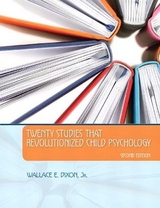
Twenty Studies That Revolutionized Child Psychology
Pearson (Verlag)
978-0-13-041572-1 (ISBN)
- Titel erscheint in neuer Auflage
- Artikel merken
For undergraduate courses in Child Development/Psychology, Life Span Development, Child and Family Studies, and Human Growth and Development.
This text gives students a systematic look at the process of child psychology research by examining the twenty most revolutionary scientific investigations in the field over the course of the last fifty years. The individual chapters are dedicated to each revolutionary study.
1. Introduction.
I. SEVEN STUDIES THAT REVOLUTIONIZED COGNITIVE AND LANGUAGE DEVELOPMENT.
2. From mollusks to Rugrats: Biological Principles and Psychological Ideas.
3. When Thinking Begins.
Piaget, J. (1952). The origins of intelligence in children. New York: International Universities Press.
4. A Marxist Revolution in Psychology.
Vygotsky, L.S. (1978). Mind in society: The development of higher psychological processes. Cambridge, MA: Harvard University Press.
5. The Eyes Have It.
Fantz, R. L. (1961). The origin of form perception. Scientific American, 204, 66-72.
6. The Drawbridge Studies.
Baillageon, R. (1987). Object permanence in 3.5- and 4.5-month-old infants. Developmental Psychology, 23, 655-664.
7. “Do You Know What I Know?”
Premack, D., & Woodruff, G. (1978). Does the chimpanzee have a theory of mind? The Behavioral and Brain Sciences, 1, 515-526.
8. Language Development and the Big Bang Theory.
Chomsky, N. (1957). Syntactic structures. The Hague: Mouton.
9. Adam and Eve and the Garden of Eden.
Brown, R. (1973). A first language: The early stages. Cambridge, MA: Harvard University Press.
II. SIX STUDIES THAT REVOLUTIONIZED SOCIAL DEVELOPMENT AND PARENTING.
10. She Loves Me, But She Loves Me Not.
Harlow, H., & Harlow, M. (1965). The affectional systems. In A. Schrier, H. Harlow, & F. Stollnitz (Eds.), Behavior of non-human primates. New York: Academic Press.
11. The Invisible Bungee Cord.
Bowlby, J. (1969). Attachment and loss, Vol. 1. New York: Basic Books.
12. What a Strange Situation.
Ainsworth, M.D.S., Blehar, M.C., Waters, E., & Wall, S. (1978). Patterns of attachment. Hillsdale, NJ: Erlbaum.
13. “This Is Gonna Hurt You a lot More Than It's Gonna hurt Me.”
Baumrind, D. (1971). Current patterns of parental authority. Developmental psychology Monographs, 4 (1, part 2).
14. Monkey See, Monkey Do.
Bandura, A., Ross, D., & Ross, S. (1961). Transmission of aggression through imitation of aggressive models. Journal of Abnormal and Social Psychology, 63, 375-382.
15. The Ethic of Care: It's a Woman Thing.
Gilligan, C. (1982). In a different voice: Psychological theory and women's development. Cambridge, MA: Harvard University Press.
III. THREE STUDIES THAT REVOLUTIONIZED CLINICAL CHILD PSYCHOLOGY.
16. “If You Were Born first, I Would've Stopped.”
Thomas, A., Chess, S., & Birch, H.G. (1968). Temperament and behavior disorders in childhood. New York: New York University Press.
17. Armadillos Aren't the Only Mammals That Grow Armor.
Werner, E.E., & Smith, R.S. (2001). Journey from childhood to midlife: Risk, resilience, and recovery. Ithaca, NY: Cornell University Press.
18. Keep the Baby and the Bathwater.
Sameroff, A.J., & Chandler, M.J. (1975). Reproductive risk and the continuum of caretaker causality. In F.D. Horowitz (Ed.), Review of child development research (Vol. 4). Chicago: University of Chicago Press.
IV. FOUR STUDIES THAT REVOLUTIONIZED HOW WE DO AND THINK ABOUT CHILD PSYCHOLOGY.
19. Choreographing the Nature-Nurture Dance.
Anastasi, A. (1958). Heredity, environment, and the question “How?” Psychological Review, 89, 976—984.
20. What Comes Around Goes Around.
Bell, R.Q. (1968). A reinterpretation of the direction of effect in studies of socialization. Psychological Review, 75, 81-95.
21. Development Lessons from Kitten Brains.
Hubel, D.H., & Wiesel, T.N. (1965). Receptive fields of cells in striate cortex of very young, visually inexperienced kittens. Journal of Neurophysiology, 26, 944-1002.
22. Governments, Grade Schools, and Grocery Stores: Multiple Levels of Influence.
Bronfenbrenner, U. (1977). Toward an experimental ecology of human development. American Psychologist, 32, 513-531.
| Erscheint lt. Verlag | 15.11.2002 |
|---|---|
| Sprache | englisch |
| Maße | 233 x 178 mm |
| Gewicht | 420 g |
| Themenwelt | Geisteswissenschaften ► Psychologie ► Entwicklungspsychologie |
| ISBN-10 | 0-13-041572-3 / 0130415723 |
| ISBN-13 | 978-0-13-041572-1 / 9780130415721 |
| Zustand | Neuware |
| Haben Sie eine Frage zum Produkt? |
aus dem Bereich



